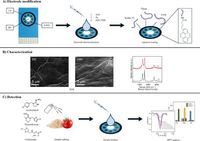A growing concern over the environmental and health impacts of neonicotinoid pesticides is prompting researchers to find innovative solutions for their detection. A study led by researchers at Khalifa University has developed a novel graphene-based electrochemical aptasensor capable of simultaneously detecting three common neonicotinoids: imidacloprid, thiamethoxam, and clothianidin. This new technology promises not only increased accuracy but also cost-effective and rapid testing for these neurotoxic substances in food samples.
Neonicotinoids, widely used in agriculture due to their effectiveness against pest populations, have also garnered negative attention for their persistence in the environment and potential harm to beneficial insects and other wildlife. The World Health Organization has recognized these substances as a significant risk factor for ecological balance, leading to increasing regulatory scrutiny worldwide.
The newly designed aptasensor utilizes specially engineered aptamers—short, single-stranded nucleic acid sequences that bind specifically to target molecules. The imidacloprid-specific aptamer was truncated to enhance its binding affinity, resulting in a much-improved performance of KD = 12.8 nM in comparison to its original sequence's KD of 20.1 nM. This improvement is crucial for the biosensor's capability to make precise measurements even at low concentrations.
The biosensor exhibited a wide linear detection range, from as low as 0.01 ng/mL to 100 ng/mL for each neonicotinoid. This is significant because most conventional detection methods are often complicated and require extensive sample processing, making them impractical for on-site testing. Unlike the currently used methods, which sometimes need advanced laboratory settings and long timelines for analysis, this electrochemical aptasensor stands out for its potential to enable rapid, on-site analyses of pesticide residues.
Tests conducted on extracts from tomatoes and rice spiked with the neonicotinoids showed impressive performance. The aptasensor achieved recovery rates between 99.0% and 100.8%, which indicate that it can reliably replicate results when compared against more traditional methods such as liquid chromatography-tandem mass spectrometry (LC-MS/MS). The LC-MS/MS findings, in comparison, varied more widely with percentages fluctuating between 76.0% to 118.7% recovery.
"High recovery rates for all three neonicotinoids were obtained, demonstrating excellent agreement between the two methods," stated the authors of the article. This validation underscores the aptasensor's reliability and offers a substantial advancement for fields requiring sensitive pesticide detection.
In practical terms, the biosensor displayed limits of detection (LOD) of 6.30 pg/mL for imidacloprid, 6.80 pg/mL for clothianidin, and 7.10 pg/mL for thiamethoxam—values that are significantly lower than the limits set by European regulatory bodies for safe pesticide levels in food products. These improvements suggest that the developed aptasensor can safely detect residues that are well within acceptable limits, contributing to food safety monitoring.
The affordability of graphene-based materials used in constructing the aptasensor not only encourages widespread adoption, but also enhances accessibility for smaller agricultural operations that may not have had the means to implement traditional testing avenues. The move toward cost-effective technology in the detection of harmful substances holds promise for better regulatory compliance and safer agricultural practices.
As agricultural practices worldwide are scrutinized more closely in light of environmental and health considerations, the introduction of practical tools like the multiplexed aptasensor can pave the way for innovative monitoring approaches. The integration of such technologies into everyday farm management practices could dramatically enhance the safety of food products and reduce harmful pesticide residues in the ecosystem.
In summary, the research highlights a significant leap forward in the detection of neonicotinoids. As stated by the authors, "This study presents a cost-effective and simple multiplex detection for the sensitive, specific, and accurate on-site analysis of neonicotinoids." With further validation and societal acceptance, this aptasensor could become a viable standard in agricultural monitoring.

